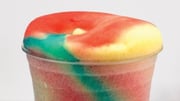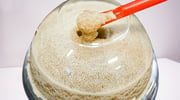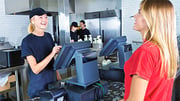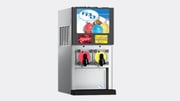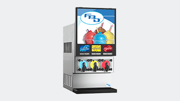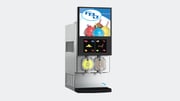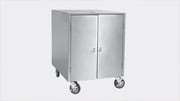-
Products
-
Industries
Industries
Quickly increase your profits by meeting the growing demand for frozen beverages.
-
All Dispensers
All Dispensers
We offer low maintenance, reliable and innovative custom-built equipment.
-
Resource Center
Resource Center
Get technical support, download training materials, and learn more about the frozen beverage industry.
Support & Services Resources
Resources
-
Careers
Careers
Enjoy a fast-paced, high-growth, fun work environment with great benefits
-
About
About
Your Reliable Partner for Frozen Beverage Success
Service Codes
1X - Syrup Out
The syrup pressure is less than 45 PSI.
- Replace the empty BIB.
- Ensure the CO2 line is connected to the BIB pump.
- Ensure the BIB pump is operating correctly.
- Ensure the CO2 tank is not empty.
- Ensure the syrup shutoff valve at the solution module is turned on.
- Ensure any syrup shutoff valves at the back of the unit aren’t turned off.
- Ensure the syrup supply pressure at the dispenser is reading 70 PSI. Adjust the regulator if needed.
- nsure the syrup pressure transducer is connected and working properly.
20 - CO2 Out
The CO2 pressure is less than 45 PSI.
- Replace or refill the CO2 tank.
- Ensure a CO2 shutoff valve at the back of the unit isn’t turned off.
- Ensure the CO2 pressure transducer is connected and working properly.
- Ensure the CO2 supply pressure at the dispenser is reading 70 PSI. Adjust the regulator if needed.
30 - Water Out
The water pressure is less than 45 PSI.
- Ensure the water line to the unit is on and that the water shutoff at the solution module is turned on.
- Ensure the CO2 supply line is connected to the water pump and that the pump is not stalled.
- Ensure the CO2 supply pressure at the dispenser is reading 70 PSI. Adjust the regulator if needed.
- Ensure the water pressure transducer is connected and working properly.
4X - Tank PSI = 0
The tank pressure did not rise from 0 PSI when filling.
- Run the fill diagnostic sequence to determine the reason for the failure.
5X - Safety Fill Error
A barrel filled continuously for more than two minutes.
- Run the fill diagnostic sequence to determine the reason for the failure.
6X - Beater Low Error
A beater motor stalled during operation.
- Check the brix in the barrel. If low, check the brix at the sample valve and adjust if needed. Drain and refill the barrel.
- Check the fault code history for multiple sold out errors within a short period. This can mean that the BIB connector or syrup pump has a suction leak. Fix if necessary.
- Run the beater circuit diagnostic if a component failure is suspected.
70 - Compressor Ran Too Long
The compressor ran continuously for more than 90 minutes.
- Is the location an extreme volume venue such as a festival? If so, contact FBD service for instructions on adjusting the timer.
- Run the refrigeration diagnostic sequence to determine the reason for the failure.
8X - High Barrel Pressure
The pressure on a barrel exceeded 55 PSI
- Dispense a drink to reduce the barrel pressure. The unit will refreeze if set to the ON mode.
- Run the fill diagnostic if a failed component is suspected.
- Check the "Active Charge" regulator located on the product header to ensure it is set at 30 PSI. All barrels should be fully depressurized before checking the active charge.
90 - Hot Product Detected
The system shut down because product in a barrel exceed 85°F
- Check the return temperature sensor for proper operation.
- Check to see if the operating system has malfunctioned (is it responding to button presses, is it freezing down). Run it through a defrost cycle and watch the return temperature and refrigeration pressures.
10X - Possible Low Brix
There have been multiple low beater errors (error# 06X) within a time period.
- Check the brix in the barrel. If low, check the brix at the sample valve and adjust if needed. Drain and refill the barrel.
- Check the fault code history for multiple sold out errors within a short period. This can mean that the BIB connector or syrup pump has a suction leak. Fix if necessary.
11X - Motor Failure
The beater motor is not operating.
- Run a beater circuit diagnostic to determine the problem or refer to error #58X in this manual.
- Check to make sure the beater motor is plugged in.
12X - Beater High Error
The control board is not reading the proper value from the beater motor.
- Run a defrost cycle to reset the motor baseline value.
- Run a beater circuit diagnostic to determine the problem or refer to error #58X in this manual.
130 - Board failure
The control board is not functioning properly.
- Cycle the power to the unit to see if it will clear the error. Replace the control board.
140 - Low regulated CO2 PSI
The regulated CO2 pressure dropped below 50 PSI.
- Ensure the CO2 supply is not low.
- Check the "carbonation" regulator on the header tray and ensure it is set to 60 PSI.
150 - High regulated CO2 PSI
The regulated CO2 pressure is above below 70 PSI.
- Check the "carbonation" regulator on the header tray and ensure it is set to 60 PSI.
160 - Low Line Voltage
The voltage supply is below 200 volts
- Install a boost transformer. If the voltage is slightly above 200 it is still needed as fluctuations in power during the day or during unit operation will cause it to drop below 200 volts.
170 - High Line Voltage
The voltage supply is above 254 volts
- Install a buck transformer.
180 - LPSI transducer
The low side refrigeration pressure is not reading correctly.
- Ensure the pressure transducer is plugged in.
- Replace the transducer if faulty.
190 - HPSI transducer
The high side refrigeration pressure is not reading correctly.
- Ensure the pressure transducer is plugged in.
- Replace the transducer if faulty.
200 - Return Temperature Sensor
The refrigeration return (suction) temperature sensor is not reading correctly.
- Ensure the temperature sensor is plugged in.
- Replace the sensor if faulty.
210 - Refrigeration Malfunction
The refrigeration pressures were not in the correct range.
- Run the fill diagnostic sequence to determine the reason for the failure.
240 - Active Charge Cannot Vent
Error occurs if the DCC module has attempted to vent five times unsuccessfully. The active charge pressure will not decrease to the target pressure range.
- Verify the vent solenoid is electrically opening and closing using the MANUAL ON/OFF menu.
- Verify the fill and vent solenoid inputs are not swapped.
- Verify that gas is not bypassing the fill solenoid in the DCC module. Disconnect both solenoid harness connections and verify the active charge pressure on the READOUTS menu is not climbing. If the pressure reaches the incoming gas pressure, then the fill solenoid is leaking.
- Ensure that syrup has not entered the active charge system due to a failed expansion tank. This may cause the orifice in the DCC module to be clogged.
250 - Active Charge Cannot Fill
The DCC module has attempted to fill five times unsuccessfully, the active charge pressure will not decrease to target pressure range.
- Verify the fill solenoid is electrically opening/closing using the MANUAL ON/OFF menu.
- Verify the fill and vent solenoid inputs are not swapped. Verify “Active Charge” input on the harness is plugged into the pressure transducer on the DCC module.
- Verify no gas is leaking out of the active charge system. Check any new tubing/Oetikers that were installed for leaks. Disconnect both solenoid harness connections and verify the active charge pressure on the READOUTS menu is not slowly decreasing to 0 PSIG (0 kPag).
- Verify that syrup or debris has not entered the incoming gas line. Check screen in fill orifice. Dispenser does not have a DCC. Change the ACTIVE CHARGE setting to DISABLED in the SETTINGS menu.
270 - Air Out
The compressed air pressure is less than 45 PSIG (310 kPag).
- Verify there is a supply of compressed air.
- Ensure the compressed air shutoff valve at the back of the dispenser is not turned off.
- Ensure the gas pressure transducer is connected and working properly.
- Ensure the compressed air supply pressure at the dispenser is reading 70 PSIG (483 kPag). Adjust the regulator if needed.
280 - Nitrogen Out
The N2 pressure is less than 45 PSIG (310 kPag).
- Replace or refill the N2 tank.
- Ensure the N2 shutoff valve at the back of the dispenser is not turned off.
- Ensure the N2 pressure transducer is connected and working properly.
- Ensure the N2 supply pressure at the dispenser is reading 70 PSIG (483 kPag). Adjust the regulator if needed.
290 - Gas #1 - CO2 Out
The CO2 pressure is less than 45 PSIG (310 kPag) for Gas #1.
- Replace or refill the CO2 tank.
- Ensure the CO2 shutoff valve at the back of the dispenser is not turned off.
- Ensure the CO2 pressure transducer is connected and working properly.
- Ensure the CO2 supply pressure at the dispenser is reading 70 PSIG (483 kPag). Adjust the regulator if needed.
300 - Door Communication
The dispensers main control board cannot communicate to the door. Communication occurs through the orange/yellow/black wire harness between the dispenser’s main control board and the door.
- Verify door is powered and displaying flavor selection interface. There should be a matching error message on the doors display. If not, cycle the power to the door.
- Open door. Ensure the 4-pin connector on the serial harness (12-3116-0179, orange/yellow/black wires) is connected between the dispenser and the door.
- Disconnect power from dispenser. Open electrical box and ensure the serial harness (12-3116-0179) is connected to the serial port (P2) on control board.
- Unscrew back panel of door. Ensure the serial harness is connected to J_RS232 on door board.
- Replace any damaged or defective harnesses.
320 - Low Regulated N2 PSI
The regulated N2 pressure dropped below 50 PSIG (345 kPag).
- Ensure the N2 supply is not low.
- Check the gas regulator on the header tray and ensure it is set to 60 PSIG (414 kPag).
330 - High Regulated N2 PSI
The regulated N2 pressure is above 70 PSIG (483 kPag).
- Check the gas regulator on the header tray and ensure it is set to 60 PSIG (414 kPag).
340 - Flavor Add-on Board Missing
The dispenser cannot detect the flavor add-on board. The board is missing or damaged.
- Ensure the software matches the dispenser’s hardware configuration.
- Ensure the flavor add-on board is installed and seated properly on the control board.
- Replace the flavor add-on board if faulty.
35X - Flavor Out 1
The pressure for flavor syrup is less than 45 PSIG (310 kPag), where the “Out” number represent the flavor number.
- Replace the empty BIB.
- Ensure the gas line is connected to the BIB pump.
- Ensure the BIB pump is operating correctly.
- Ensure the gas tank is not empty.
- Ensure any syrup shutoff valves at the back of the dispenser are not turned off.
- Ensure the syrup supply pressure at the dispenser is reading 70 PSIG (483 kPag). Adjust the regulator if needed.
- Ensure the syrup pressure transducer for that flavor is connected and working properly.
36X - Flavor Out 2
The pressure for flavor syrup is less than 45 PSIG (310 kPag), where the “Out” number represent the flavor number.
- Replace the empty BIB.
- Ensure the gas line is connected to the BIB pump.
- Ensure the BIB pump is operating correctly.
- Ensure the gas tank is not empty.
- Ensure any syrup shutoff valves at the back of the dispenser are not turned off.
- Ensure the syrup supply pressure at the dispenser is reading 70 PSIG (483 kPag). Adjust the regulator if needed.
- Ensure the syrup pressure transducer for that flavor is connected and working properly.
37X - Flavor Out 3
The pressure for flavor syrup is less than 45 PSIG (310 kPag), where the “Out” number represent the flavor number.
- Replace the empty BIB.
- Ensure the gas line is connected to the BIB pump.
- Ensure the BIB pump is operating correctly.
- Ensure the gas tank is not empty.
- Ensure any syrup shutoff valves at the back of the dispenser are not turned off.
- Ensure the syrup supply pressure at the dispenser is reading 70 PSIG (483 kPag). Adjust the regulator if needed.
- Ensure the syrup pressure transducer for that flavor is connected and working properly.
38X - Flavor Out 4
The pressure for flavor syrup is less than 45 PSIG (310 kPag), where the “Out” number represent the flavor number.
- Replace the empty BIB.
- Ensure the gas line is connected to the BIB pump.
- Ensure the BIB pump is operating correctly.
- Ensure the gas tank is not empty.
- Ensure any syrup shutoff valves at the back of the dispenser are not turned off.
- Ensure the syrup supply pressure at the dispenser is reading 70 PSIG (483 kPag). Adjust the regulator if needed.
- Ensure the syrup pressure transducer for that flavor is connected and working properly.
390 - No ADA Keypad Detected
The ADA keypad is missing, disconnected or damaged.
- Ensure ADA keypad has no visible damage.
- Ensure the keypad connector is plugged in correctly. Make sure that the arrows on each connector align.
- Replace the keypad if faulty.
400 - ADA Keypad Shorted
The ADA keypad button(s) are damaged or have been pressed longer than 12 seconds.
- Ensure the ADA keypad is connected correctly. Make sure that the arrows on each connector align.
- Replace the keypad if faulty.
410 - Gas #1 - N2 Out
The nitrogen (N2) pressure is less than 45 PSIG (310 kPag) for Gas #1.
- Replace or refill the N2 tank.
- Ensure the N2 shutoff valve at the back of the dispenser is not turned off.
- Ensure the N2 pressure transducer is connected and working properly.
- Ensure the N2 supply pressure at the dispenser is reading 70 PSIG (483 kPag). Adjust the regulator if needed.
420 - Gas #2 - N2 Out
The nitrogen (N2) pressure is less than 45 PSIG (310 kPag) for Gas #2.
- Replace or refill the N2 tank.
- Ensure the N2 shutoff valve at the back of the dispenser is not turned off.
- Ensure the N2 pressure transducer is connected and working properly.
- Ensure the N2 supply pressure at the dispenser is reading 70 PSIG (483 kPag). Adjust the regulator if needed.
430 - Gas #2 - CO2 Out
The CO2 pressure is less than 45 PSIG (310 kPag) for Gas #2.
- Replace or refill the CO2 tank.
- Ensure the CO2 shutoff valve at the back of the dispenser is not turned off.
- Ensure the CO2 pressure transducer is connected and working properly.
- Ensure the CO2 supply pressure at the dispenser is reading 70 PSIG (483 kPag). Adjust the regulator if needed.
440 - Gas #1 - Low Regulated CO2 PSI
The regulated CO2 pressure dropped below 50 PSIG (345 kPag) for Gas #1.
- Ensure the CO2 supply is not low.
- Check the “Gas 1” regulator on the header tray and ensure it is set to 60 PSIG (414 kPag).
450 - Gas #1 - High Regulated CO2 PSI
The regulated CO2 pressure is above 70 PSIG (483 kPag) for Gas #1.
- Check the “Gas 1” regulator on the header tray and ensure it is set to 60 PSIG (414 kPag).
460 - Gas #1 - Low Regulated N2 PSI
The regulated N2 pressure dropped below 50 PSIG (345 kPag) for Gas #1.
- Ensure the N2 supply is not low.
- Check the “Gas 1” regulator on the header tray and ensure it is set to 60 PSIG (414 kPag).
470 - Gas #1 - High Regulated N2 PSI
The regulated N2 pressure is above 70 PSIG (483 kPag) for Gas #1.
- Check the “Gas 1” regulator on the header tray and ensure it is set to 60 PSIG (414 kPag).
480 - Gas #2 - Low Regulated CO2 PSI
The regulated CO2 pressure dropped below 50 PSIG (345 kPag) for Gas #2.
- Ensure the CO2 supply is not low.
- Check the “Gas 2” regulator on the header tray and ensure it is set to 60 PSIG (414 kPag).
490 - Gas #2 - High Regulated CO2 PSI
The regulated CO2 pressure is above 70 PSIG (483 kPag) for Gas #2.
- Check the “Gas 2” regulator on the header tray and ensure it is set to 60 PSIG (414 kPag).
500 - Fan not turning on
The condenser fan did not activate during the refrigeration diagnostic test
- Remove control board and check for a blown fan fuse (F1 and F2). If a fuse is blown then a fan or capacitor malfunction may be possible.
- If fuses are OK, reinstall control board.
- Disconnect wiring harnesses at fan capacitor.
- Manually turn fan on and check for line voltage (230V) between the connectors removed from the capacitor. If no voltage is present then replace control board.
- If correct voltage is present then substitute a "known to be good" capacitor and try to operate fan again.
- If fan fails to start with good capacitor then replace both fan and capacitor.
510 - Compressor not turning on
The compressor did not activate during the refrigeration diagnostic test.
- Manually turn on compressor and ensure the contactor located in the electrical box engages.
- If contactor does not engage then check for 24 VAC at the contactor coil. Note: The voltage will read ~19 VAC when not powered. Refer to the wiring schematic for details. If no voltage, install a new control board and check for 24 VAC again.
- If 24 VAC is present at the contactor coil but it does not engage then replace the contactor.
- If contactor engages, check to make sure the voltage at contactor terminals T1 and T2 is above is above 187 V when the compressor is starting. If below 187 V, the line voltage supply needs to be corrected.
- If voltage at T1 and T2 is good then substitute a "known to be good" run capacitor. If compressor starts, replace the original run capacitor.
If compressor still won’t start: - Remove the wires from the compressor and check for continuity between the C-R, C-S and R-S terminals of the compressor. If the compressor is hot, a lack of continuity can indicate a tripped thermal protector. It may take considerable time for the compressor to cool down and reset the protector. If continuity cannot be established through all motor windings when cooled down, the compressor should be replaced.
- Check the compressor motor for a ground fault by conducting a continuity check between the common terminal (C) and the compressor shell. If there is continuity then replace the compressor.
- Check the compressor motor windings for proper resistance using the table below. If out of spec then replace the compressor.
Compressor Winding Resistance
| Model | C-R | C-S |
|---|---|---|
| Copeland ZB15KCE-PFV | 0.94-1.08 | 2.12-2.44 |
| Copeland ZB19KCE-PFV | 0.84-0.97 | 2.52-2.90 |
| Copeland ZB19KCE-PFJ | 1.12-1.28 | 2.07-2.39 |
52X - Refrigeration solenoid stuck open
The diagnostic test determined that a refrigeration solenoid was stuck open.
- Verify the solenoid is not activated by going to the Manual ON/OFF. Remove wiring from the suspect solenoid and check for 24 VAC. Note: The voltage will read ~19 VAC when not powered.
- If no voltage (~19 VAC) then replace the solenoid valve.
- If 24 VAC is present then replace the control board
53X - Defrost solenoid stuck open
The diagnostic test determined that a defrost solenoid was stuck open.
- Verify the solenoid is not activated by going to the Manual ON/OFF. Remove wiring from the suspect solenoid and check for 24 VAC. Note: The voltage will read ~19 VAC when not powered.
- If no voltage (~19 VAC) then replace the solenoid valve.
- If 24 VAC is present then replace the control board
540 - Low refrigeration pressure
The refrigeration diagnostic test indicates the refrigeration charge is low.
- The low side refrigeration pressures (as read on LCD display) during a single barrel freeze cycle should be between 40-55 PSI and the high side above 250 at 75 degree ambient.
- If you suspect the refrigeration charge is low, locate leak and repair. Refer to nameplate on the back of the dispenser for proper charge using 404A refrigerant.
550 - Excessive refrigeration pressure
The refrigeration diagnostic test indicates the refrigeration pressure is too high.
- The high side refrigeration pressures (as read on LCD display) during a freeze cycle should not exceed 450 PSI.
- Ensure dispenser has 3" clearance on sides and back and no obstructions overhead. Failure to provide adequate clearances will result in poor airflow or the recirculation of hot discharge air from the condenser.
- Ensure the dispenser is not operating in temperatures over 104 deg F.
- Ensure the condenser air filter is clean.
- Refer to nameplate on the back of the dispenser for proper charge using 404A refrigerant.
56X - Refrigeration solenoid not opening
The diagnostic test determined that a refrigeration solenoid did not open open.
- Remove the wiring harness from the suspect solenoid.
- Manually turn on the solenoid and check for 24 VAC at the wiring harness. Note: The voltage will read ~19 VAC when not powered.
- If 24 VAC is present then replace the solenoid.
- If no voltage then replace the control board.
57X - Defrost solenoid not opening
The diagnostic test determined that a defrost solenoid did not open.
- Remove the wiring harness from the suspect solenoid.
- Manually turn on the solenoid and check for 24 VAC at the wiring harness. Note: The voltage will read ~19 VAC when not powered.
- If 24 VAC is present then replace the solenoid.
58X - Beater motor not turning on
The beater circuit diagnostic test determined that a beater motor was not operating.
- Remove the control board and check for blown motor fuses (Motor 1: F3 & F4, Motor 2: F5 & F6, Motor 3: F7 & F8, Motor 4: F9 & F10). If a fuse is blown then motor or capacitor malfunction may be possible.
- If fuses are OK, reinstall control board.
- Disconnect wiring harness from suspect beater motor.
- Manually turn on beater motor and ensure there is line voltage on pins 1 & 3 of supply harness (outside pins).
- If correct voltage is present then substitute a "known to be good" capacitor and try to operate motor again.
- If motor fails to start with good capacitor then replace both motor and capacitor.
59X - CO2 solenoid not opening
The fill circuit diagnostic test determined that a CO2 solenoid was not opening.
- Disconnect the electrical harness from the CO2 solenoid for the barrel in question.
- Manually activate the solenoid and check to make sure there is 12 VDC at the connection. Note: The voltage will read ~2 VDC when not powered. If no voltage then replace the control board.
- If correct voltage is present then replace the solenoid. Be sure to turn off CO2 supply before disconnecting the CO2 line from the solenoid.
- If solenoid is functioning properly then a leak may be present in the product delivery system. Check the relief valve, dispensing valve, rear seal and tubing in the product tray for leaks.
- If no leaks are found then the tank pressure transducer may be defective.
60X - Solution solenoid not opening
The fill circuit diagnostic test determined that a solution solenoid was not opening.
- Disconnect the electrical harness from the suspect solution solenoid.
- Manually activate the solenoid and check for 24 VAC at the connection. Note: The voltage will read ~19 VAC when not powered. If no voltage then replace the control board.
- If correct voltage is present then remove the solution module and then replace the solenoid.
61X - CO2 or Solution Leak
A CO2 or solution solenoid leak is causing the barrel pressure to rise during a fill circuit diagnostic test.
- Determine if the barrel is filling with CO2 or liquid. If the barrel liquid level is low enough use a flashlight to look at the back of the barrel and see if liquid is entering the barrel. Replace a leaking solenoid.
- Ensure the solenoids are not manually turned on by going to the manual on/off menu. Check to see if either solenoid is receiving power by removing the leads and testing with a volt meter. If 12 VDC is measured on the CO2 solenoid or 24 VAC is measured on the solution solenoid then replace the control board.
62X - Barrel Leak
The barrel pressure is dropping during a fill circuit diagnostic test.
- Look for any obvious leaks by searching for liquid along the product line from the solution module to the back of the barrel.
- Inspect the rear seal to determine if the leak is originating from it. Inspect the relief valve in the faceplate to determine if the leak is originating from it. Press and turn the relief valve to firmly seat.
- Inspect the dispensing nozzle to determine if the leak is originating from it.
630 - Refrigeration Pressure Transducer Offset
The pressure transducers were not reading correctly during the refrigeration diagnostic test.
- Attach a set of refrigeration gauges that are known to be accurate and then compare the gauges to the readings on the LCD. Replace the pressure transducer that is reading incorrect.
1000 - Gas #2 - Low Regulated N2 PSI
The regulated N2 pressure dropped below 50 PSIG (345 kPag) for Gas #2.
- Ensure the N2 supply is not low.
- Check the “Gas 2” regulator on the header tray and ensure it is set to 60 PSIG (414 kPag).
1010 - Gas #2 - High Regulated N2 PSI
The regulated N2 pressure is above 70 PSIG (483 kPag) for Gas #2.
- Check the “Gas 2” regulator on the header tray and ensure it is set to 60 PSIG (414 kPag).
102X - Syrup #2 Out
The secondary syrup pressure is less than 45 PSI.
- Replace the empty BIB.
- Ensure the gas line is connected to the BIB pump.
- Ensure the BIB pump is operating correctly.
- Ensure the gas tank is not empty.
- Ensure the syrup shutoff valve at the solution module is turned on.
- Ensure any syrup shutoff valves at the back of the dispenser are not turned off.
- Ensure the syrup supply pressure at the dispenser is reading 70 PSIG (483 kPag). Adjust the regulator if needed.
- Ensure the syrup pressure transducer is connected and working properly.
1030 - Power Restored
The unit was connected to power. Control board logs whenever unit is powered ON, no action is required.
1040 - Clock Reset
The unit’s time is not valid, and unit’s clock has been reset.
- Replace the CR2032 3V battery on the control board. Battery is used to preserve clock when unit is disconnected from power.
- Set the date and time in the “CLOCK AND SCHEDULES” menu

